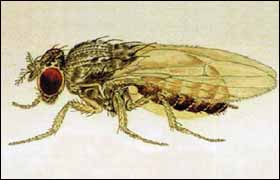Alex Doron

The research model - the fruit fly ("Drosophila in research at the Weizmann Research Institute"). Genes like humans * A transport vehicle and its name is "type"
The very complex process of differentiation of the cells of the embryo - starting from the cell formed by the union of sperm and egg, through the stages of division, reproduction until the various organs are formed and developed - results from the activity of the genetic array in the cell, and many proteins participate in it.
Not all genes are equally active. There are among them those who are dormant and inactive at a certain stage in the process - who later wake up. The question that troubled many scientists was: who and what determines which genes will begin to express, and when - and thus will cause the formation of a certain protein that will come into action?
Studies have revealed that it is a series of signals that the cell receives "from the outside world": a hormone molecule, a protein secreted by other cells. The protein molecule binds to a unique receptor in the receptor cell membrane. This communication sets off a biochemical chain reaction, in which communication messages are passed between the hormone molecule and from molecule to molecule inside the cell - until the last link in the chain delivers its message to the genetic material in the cell nucleus, for the purpose of activating a gene. As a result, a protein is formed, which changes the structure and function of the cell.
In this process, as mentioned, different groups of cells are created from one cell: from one group - a muscle develops. From another - nerve cells. From the third - blood cells, and so on. However, it turns out that this process of biochemical and intracellular communication is initiated by itself as a result of a complex process, which begins outside the cell and affects the attachment and strength of that message molecule, of the hormone or protein.
Two research groups from the Department of Molecular Genetics at the Weizmann Institute dealt with these issues. One was headed by Dr. Naama Barkai and the other by Prof. Ben-Zion Sheila, together with scientists from Manchester, England. The result: a mathematical model for accurate prediction of the process.
Their research revealed that the communication proteins secreted by the various cells are dispersed in the intercellular space, according to a fixed pattern of spatial dispersion. The concentration rate of the proteins in the different regions of the embryo - and their proximity to certain target cell receptors - affect the attachment and its strength. This causes the process to start and determines the direction of the "raw" cell differentiation. That is: if it is done to a muscle, bone, nerve or blood cell.
And it turns out that the communication proteins scattered in the above-mentioned space do not change their position on their own. They need a "transport vehicle" - and this is a carrier protein named "SOG" (SOG), which was discovered
in this work.
The researchers noted that "type" is a central, universal and present factor in other systems of the distribution of communication proteins, which takes place in the spaces between the cells, when the cells communicate with each other (transmitting messages, from a transmitting cell to a receiving cell).
The built model predicts the degree of vitality of SOG and how necessary it is for the system, in order to operate reliably and safely in a "noisy environment", biologically speaking. When the differentiation takes place, other biological processes take place in the "cellular environment": genetic changes (mutations), temperature changes and others.
By the way: the research was carried out using Drosophila - the fruit fly (known today as the "research Drosophila"). The genes and proteins responsible for building different stages in the chemical communication pathway in flies are similar to their counterparts in developed animals, including humans. Which indicates that the principles of differentiation in embryonic cells are fundamental in all of nature.
https://www.hayadan.org.il/BuildaGate4/general2/data_card.php?Cat=~~~393698708~~~48&SiteName=hayadan
